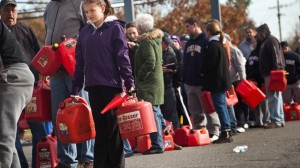When a natural disaster of some sort occurs, one of the first things to happen is an immediate increase in the demand for gasoline. I can remember watching people who stood in line for hours, maybe even days, after Hurricane Sandy struck the east coast. If gas was even available prices were through the roof, the amount of fuel one could purchase was rationed and lines stretched for blocks. Woe be unto the person who had less than 1/4 tank of fuel in their vehicle just prior to the hurricane making landfall.

Gas shortages after Hurricane Sandy
There are a few ways to avoid being like the individuals pictured above, which basically boils down to having extra gasoline on hand when a shortage occurs. The first and easiest thing to do is to always fill up your vehicle one it reaches 1/2 a tank. This way at no point in time will your vehicle ever slip below 1/2, thus giving you at least 150-200 miles driving range should the pumps go down.
The second and often more controversial method involves having gasoline stored on site in the ever popular red containers. Usually this is done with 5 gallon containers, although I have a few 6 gallon ones too. There are a few problems associated with doing this and you must be more proactive to avoid them. There is an obvious fire hazard risk posed by having 20 gallons of fuel sitting in a garage or storage shed, or even worse the basement (NOT recommended). Although easily transportable, the red fuel containers are not air tight and because of this the fuel quality degrades over time. While you might be able to use some of that 2 year old fuel to run your lawnmower, it probably wouldn’t be best to put that into your car.
The question then remains, how to avoid the problems associated with storing fuel on site for emergencies. After all having 20 gallons (4 x 5 gal container) on hand would surely be a blessing should a disaster occur. Even if your vehicle gets terrible gas mileage, 20 gallons of extra fuel could get you through a week or two of in town driving, or extend the range long enough so that you could locate working gas stations outside of the disaster area. While your personal storage solution is completely up to you here is what I have found to be effective.
1- Store the gas in a well ventilated area. I use my garage which gets plenty of air flow, and I never expose the gas cans to direct sunlight.
2- ROTATE through your supply. Realizing that the shelf life of the gas is short, maybe 3 months or so, I simply pour the gas into the vehicle and then refill the can(s). If you establish a staggered pattern it will alleviate having to do this with all of the cans at once.
By conducting my gasoline storage method in this way I avoid having to worry about fuel stabilizers or shelf life calculations. This combined with always keeping my vehicle’s tank above 1/2 hopefully ensures that should a disaster occur, I won’t be the guy standing in line for 10 hours in freezing temps just hoping to pay $10 a gallon for 2 gallons of rationed fuel.









13 comments
Skip to comment form
I need to do better at this. We have the gas cans, but used all the fuel when it was time to rotate. We basically rotated without filling up the cans again. ohh. umm. Fail.
Author
It can get tricky, especially if you dont have a good way to tie down the gas cans while transporting them in your vehicle.
I learned the hard way also after Hurricane katrina. So now I have a buried 200 gal heavy duty steel fuel tank in my back yard. Filling it as needed using when not. Any storm brewing in the gulf, I’ll have 150 gals in there.
Author
Any recommendations on sources to purchase tanks like that from?
I have three 5 Gal safety gasoline cans. They are numbered 1, 2, and 3. As my auto needs fuel I use one of them and then refill it. To remember which to use next I place a small magnet on the next one to be used and transfer the magnet to each in turn as they are used.
Author
Great point about numbering the cans, I should have included that in the article.
I built my own out of 1/4″ plate. I got my dimensions from Lowe’s and Homedepot looking at there tanks on hand. It ran me about $600. It took several weekends to finish. But well worth the work
Author
That’s some serious DIY right there, at least it would be for me. Congrats on a job well done.
Something that must be pointed out is the specific rules of your fire insurance policy. Many policies have very strict limits to how many gallons can be stored in an attached structure to your house. If your house burns down and they find out you had 20 gallons of gas in your attached garage, you might be out SOL with a null and void insurance policy.
The same rule goes fo propane tanks.
Call your insurance company to find out.
I am currently putting up a small “RoughNeck” brand shed away from my house at the end of my property line next to a field in the shade just to put my gas cans in.
$300 for the shed is well worth the price to keep my policy intact.
Also, I would have loved to see a comparison between metal cans and plastic cans for long term storage. Any thoughts on that.
Author
Tom,
I too was wondering about the difference between metal and plastic, but I don’t think there would be much benefit there (as far as extending the life of the fuel). Maybe if the metal cans were absolutely air tight this could play a role, but I’m not sure if they are. As to your insurance point, I’d have to agree that it could certainly be a factor if only your house burnt to the ground and investigators were seeking answers. Then again most preppers have lots of flammable stuff laying around 🙂
I called my insurance provider today. I was told there is no restriction for storing gas in an attached garage, as long as it is for personal use. Business use is different.
I was glad to hear that. Now I can store that 600 gallon tank in my garage! 🙂
Author
Game on! I’m putting a 1,000 gallon tank in my spare bedroom. 🙂 Thanks for the update Tom.
I was lucky that my family were farmers, so I ended up with several things that have helped me in this regard. I have two 1,000 gallon tanks and a 30kw diesel generator that were once part of the family farm. I use diesel regularly anyway, so rotation is not an issue and I have an older model diesel pickup (one that I can work on without all the electronics). So, my plan is to rely on diesel fuel in a SHTF scenario. Also, I have been experimenting with bio-diesel but am not quite there yet (working on it though) for long term SHTF.
For gas, right now I keep two 55 gallon drums full in the barn but I want to add a 500 gallon tank for gas to get away from the drum storage. On a side note, my area received absolutely no affects from Hurricane Katrina, but there was a panic run for about two weeks, so having gas or fuel on hand is smart even if it isn’t TEOTWAWKI.
Now, one thing to consider for tank storage of fuels is they are hard to hide and you will have to contend with the possibility of theft and plan for it.